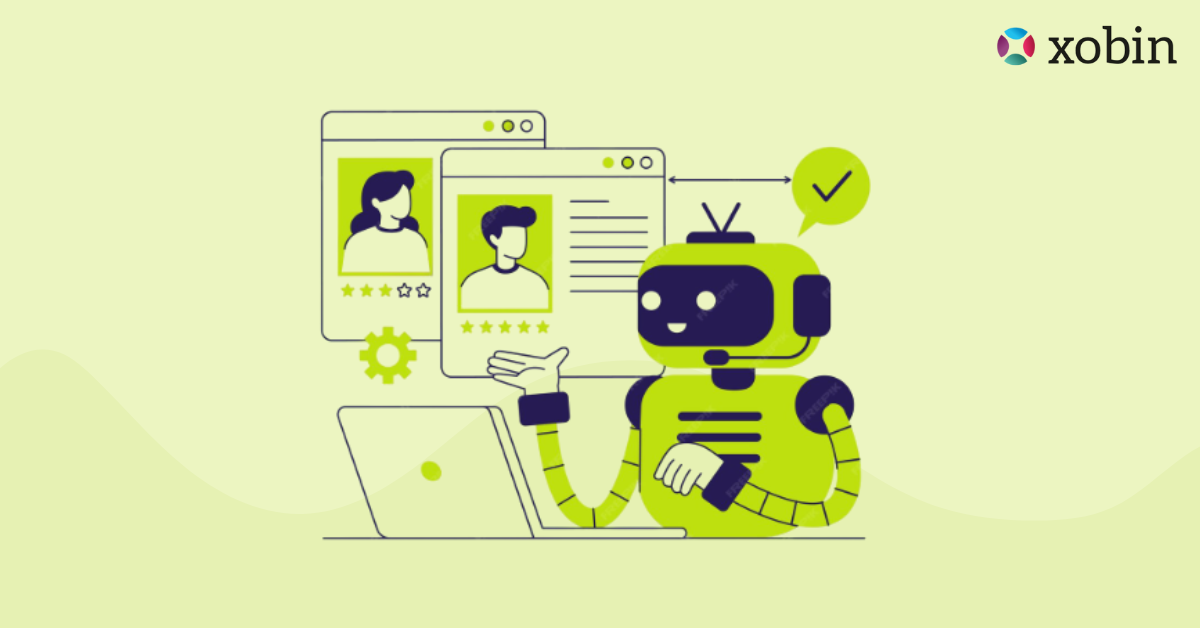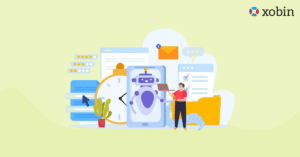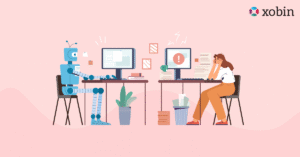Companies compete fiercely to attract top talent. Leading HR leaders now see that manual hiring processes cannot keep up with market demands. Recruitment automation transforms how organizations attract, assess, interview, and onboard high-potential candidates, turning it into a strategic necessity rather than a passing trend.
Table of Contents
From AI-powered candidate sourcing to automated onboarding, tech-driven hiring allows companies to recruit smarter, faster, and with greater accuracy. As a recruiter, you need to understand how recruiting automation works, the research-backed benefits of adopting it, and the best practices for implementing responsible AI and bias-free recruitment automation effectively.
Companies using smart recruitment software can streamline every step of the recruitment cycle, merging workflow automation with automated talent acquisition.
TL;DR – Key Takeaways!
- Recruitment automation transforms hiring into a faster, data-driven hiring process across the full recruitment cycle.
- Reduces time-to-hire by automating sourcing, screening, interviewing, and onboarding candidates
- Improves quality of hire with AI-driven recruitment, predictive insights, and hiring efficiency technology.
- Enhances candidate experience automation through timely communication and consistent branding.
- Ensures compliance and fairness with bias-aware recruiting automation and ethical AI hiring practices, supporting fair automated recruitment processes.
- Enables scalable recruitment without expanding HR headcount, supporting business growth.
- Xobin offers an integrated, AI-powered platform with ATS automation, real-time analytics, and global compliance readiness to improve hiring efficiency.
What is Recruiting Automation?
End-to-End Recruitment automation refers to using AI-driven tools and software to streamline the entire hiring process from the first candidate search to onboarding. Unlike partial automation, which might only focus on resume screening or interview scheduling, this approach can optimize every stage of the hiring funnel.
It integrates recruitment technologies to bring your scattered steps into one smooth workflow. This delivers a seamless experience for recruiters, candidates, and hiring managers.
Forward-thinking companies use this model to improve recruitment efficiency, enhance candidate experience, and ensure consistent results. Whether you’re hiring five people or five hundred, bulk recruitment becomes easier and more cost-effective.
Key stages include:
- Sourcing: Intelligent algorithms perform semantic candidate searches across databases, job boards, and professional networks, supporting automated talent pipelines.
- Screening: Automated resume screening ranks applicants based on skills, experience, and cultural fit, ensuring bias-free hiring.
- Engagement: Automation improves the candidate experience by sending faster responses and keeping communication consistent.
- Assessment: AI assessment tools offer clear, data-driven evaluations to support smarter, AI-powered hiring decisions.
- Scheduling & Interviews: Automated interview scheduling removes back-and-forth coordination, boosting efficiency.
- Onboarding: Automated onboarding and background checks prepare new hires for a smooth start.
When implemented correctly, recruitment process automation does not replace human decision-making but frees recruiters to focus on strategic priorities and candidate relationships.
Why Should Companies Automate Their Recruitment Process?
For executive leaders, recruitment is no longer just an HRM function; it is a critical driver of business performance. Every hiring delay or misstep impacts productivity, market responsiveness, and revenue. Leveraging hiring automation has become a strategic necessity backed by compelling research.
Faster Hiring Reduces Lost Productivity
An SHRM report reveals that companies take an average of 42 days to fill a position. Meanwhile, existing teams handle extra tasks, which causes burnout and lowers productivity. Implementing AI in recruitment can slash this period by over 50%, helping companies reduce time-to-hire and speed up project delivery.
Better Talent Matches Improve Long-Term Retention
Harvard Business Review reports that poor hiring choices drive 80% of employee turnover. AI recruitment tools and predictive hiring analytics examine multiple data points, from skills to culture fit, allowing data-driven hiring that boosts retention. Xobin’s adaptive skills assessments and bias-free recruitment process make hiring choices both accurate and fair.
Enhanced Candidate Experience Strengthens Employer Brand
Today’s candidates expect transparency and responsiveness. Automating candidate experience through automated recruitment tools ensures instant acknowledgment of applications, real-time status updates, and smooth interview scheduling. Research shows that 58% of candidates reject an offer after a poor recruitment experience. Recruiting automation effectively fills this gap.
Scalable Recruitment Without Increasing HR Headcount
Rapidly growing companies often strain HR teams during hiring surges. Recruitment automation handles thousands of applications, scaling hiring without adding recruiter workload. This lets leadership enter new markets smoothly, avoiding operational bottlenecks.
Compliance and Fairness Become Easier to Maintain
Top leaders are increasingly held accountable for ensuring responsible AI recruitment and fair hiring practices. Automated tracking, audit trails, and standardized talent assessments help meet global compliance standards while minimizing bias.
Data-Driven Insights for Strategic Workforce Planning
Recruitment automation software consolidates data from sourcing, screening, assessments, and onboarding stages. Executives gain dashboards for real-time visibility, allowing AI-driven hiring insights to shape proactive talent strategies instead of reactive decisions.
Benefits of Automating the Full Recruitment Process
Most leaders know that recruiting automation speeds up hiring and cuts costs, but many overlook several strategic advantages. These benefits, however, can significantly impact business performance and talent strategy. Here are some of the main advantages of automating recruitment.
Eliminating Hidden Bottlenecks
Manual processes often have unseen delays, lost emails, delayed feedback loops, or mismatched interview availability. Automated hiring tools identify and remove these bottlenecks instantly. For example, automatic interview scheduling syncs calendars and confirms times without endless email chains, ensuring no time is lost between stages.
Consistent Employer Branding at Scale
Every candidate interaction shapes your brand. Candidate experience automation ensures applicants, whether hired or not, receive consistent, timely, and professional communication. This is difficult to achieve manually when managing high-volume applications.
Enhanced Quality of Hire Through Continuous Optimization
Unlike traditional hiring, automating the recruitment process uses historical data to learn continuously. It tracks the performance of past hires, allowing AI to optimize hiring and apply predictive analytics, which refines selection criteria over time for stronger long-term results.
Reduced Bias Through Structured, Data-Driven Decisions
Subjective judgments can unintentionally influence hiring. Addressing bias in recruitment automation ensures all candidates are evaluated on predefined, role-specific criteria. This creates a fairer process, which is increasingly essential for attracting top talent in diverse global markets.
Seamless Integration Across HR Tech Stack
Automation CRM + ATS integration links sourcing talent, candidate assessment, and onboarding tools into one unified system. This provides a single source of truth for all recruitment data, allowing faster decisions and minimizing information silos.
Strengthened Compliance and Risk Management
Global hiring involves complex labor laws, data privacy regulations, and diversity reporting. Responsible AI hiring systems generate automated compliance reports, keeping organizations audit-ready while minimizing legal risks.
Empowering Recruiters to Focus on Strategic Tasks
When repetitive, low-value tasks are automated, such as automatic resume screening and background checks, recruiters can focus on candidate relationship-building, employer branding, and talent pipeline strategy. This shift from transactional to strategic recruiting can transform the HR department’s value to the organization.
Step-by-Step Recruitment Automation Workflow
A well-designed end-to-end recruitment automation workflow covers every stage of the recruitment process, ensuring no opportunity is lost and data is backed up for every decision. Below is a step-by-step breakdown that reflects how high-performing organizations leverage automation in recruitment to hire smarter and faster.
Step 1: Intelligent Job Posting and Distribution
With recruitment automation software, a single job description can be posted instantly across multiple platforms such as job boards, social media, and talent marketplaces. AI algorithms optimize the posting for relevant keywords and channels, ensuring maximum visibility to qualified candidates.
Example: Xobin’s intelligent recruitment platform connects with top boards and niche platforms, removing manual posting and reaching talent pools quickly using advanced hiring technology.
Step 2: AI Candidate Sourcing and Talent Pool Building
Instead of manual searches, AI candidate sourcing tools perform semantic candidate searches across databases, LinkedIn, and professional networks. They proactively build qualified talent pipelines using talent pipeline automation, even before positions open.
Value for leaders: Reduces reliance on last-minute sourcing and ensures a steady supply of pre-vetted candidates.
Step 3: Resume Screening Automation
Recruiters manually screen resumes, spending significant time. Resume screening automation quickly ranks and filters candidates based on set criteria, such as skills, certifications, work experience, and cultural fit.
Xobin’s AI-based resume fitment scoring ensures bias-free recruitment automation, helping you shortlist candidates objectively while maintaining compliance.
Step 4: Automated Assessments and Skill Verification
Candidates take role-specific skill tests and psychometric assessments on an AI talent skills evaluation platform. The system automatically scores and ranks them, giving hiring managers data-driven insights and AI-powered hiring optimization.
Step 5: Automated Interview Scheduling
Coordinating interview times manually often delays hiring. Automated interview scheduling syncs with recruiters’ and candidates’ calendars, eliminating back-and-forth emails.
Step 6: Structured Interviews with AI Insights
AI-enabled tools give real-time prompts, track responses, and highlight skill gaps during interviews. They support tech-driven recruitment and ensure evaluations remain consistent.
Step 7: Background Check Automation
Automated background checks verify employment history, education, and criminal records in parallel with other stages, accelerating offers while maintaining compliance.
Step 8: AI-Powered Onboarding
AI-based onboarding automates paperwork, compliance, and training schedules, enabling new hires to contribute faster. It complements automated talent acquisition workflows to ensure seamless transitions.
Step 9: Continuous Recruitment Data Analysis
Post-hire, the system tracks performance metrics of hires, feeding back into the recruitment model. This closes the loop, improving automated recruitment process outcomes over time.
Best Practices for Implementing Recruitment Automation Systems
Recruitment automation delivers measurable benefits, but its success depends on proper implementation. For recruiters, it represents more than a technology project; it drives organizational change that shapes hiring culture, workflows, and decision-making.
Start with a Clear Hiring Strategy
Automation enhances every process it touches, whether efficient or inefficient. First, map your entire hiring cycle and spot bottlenecks. Then, track metrics like time-to-hire, cost per hire, and quality of hire to measure success.
Involve Stakeholders Early
Engage recruiters, hiring managers, and department heads from the start. This ensures the automation in the recruitment system is tailored to real-world needs, not just executive expectations.
Prioritize Candidate Experience
Recruiters should treat candidate experience automation with the same importance as recruiter efficiency. Provide timely updates, enable mobile-friendly interactions, and deliver personalized communication to candidates throughout the automated recruitment process.
Integrate with Existing Systems
To maximize value, connect recruitment automation software with existing HR platforms such as your HRIS, payroll, and performance management tools. With automated CRM + ATS integration, data flows seamlessly across the employee lifecycle, reducing duplicate entry and ensuring a single source of truth.
Focus on Responsible AI Recruitment
Ethics in hiring is non-negotiable. Choose platforms with built-in bias-aware recruitment automation and compliance features. This ensures fair automated hiring and protects your employer brand from reputational risks.
Train Your Team for Maximum Adoption
Recruiters and managers can only benefit from automation tools if they are trained properly. Provide training for recruiters and managers, emphasizing how AI hiring tools support, not replace, human judgment. This encourages adoption and reduces resistance.
Optimize Continuously
Implementing hiring automation requires ongoing effort. Regularly check analytics dashboards to spot areas for improvement. Track trends in candidate quality, drop-off rates, and sourcing effectiveness to enhance the process continuously.
Scale in Phases
Start by automating high-impact tasks, such as candidate screening or interview scheduling, and then tackle the full end-to-end hiring process. This gradual approach minimizes disruption and provides quick wins to sustain momentum.
How to Ensure Fairness in AI Recruitment Automation
For executive leaders, adopting AI hiring tools brings significant efficiency gains but also introduces accountability. Regulators, candidates, and employees expect ethical AI recruitment practices that eliminate discrimination and protect privacy. Fairness is not just ethical; it’s a strategic business requirement that impacts brand reputation, legal compliance, and talent attraction.
Choose Bias-Aware Recruitment Automation
Select automated recruitment tools with built-in bias detection and mitigation. Bias-aware recruitment automation uses algorithms designed to avoid filtering candidates based on gender, ethnicity, or other irrelevant attributes, focusing instead on skills and competencies.
Audit and Monitor Algorithms Regularly
Recruitment process automation models must be checked periodically to ensure fair outcomes. Regular audits compare hiring patterns before and after implementation, ensuring the system doesn’t unintentionally exclude qualified candidates.
Maintain Human Oversight
Even advanced hiring automation systems should support, not replace, human decision-making. Recruiters and hiring managers should review final shortlists, adding a layer of judgment to AI-generated recommendations.
Provide Transparency to Candidates
Inform applicants when automation and AI tools are being used in their assessment. Transparency builds trust, especially when combined with constructive feedback on test or interview performance.
Align with Legal and Ethical Standards
Global hiring requires compliance with labor laws, data protection regulations, and diversity mandates. Use platforms that incorporate responsible and ethical AI recruitment guidelines and can generate compliance-ready reports for audits.
Collect Feedback to Improve Fairness
Implement candidate and recruiter feedback loops. This input helps refine AI models, ensuring the automated recruitment process evolves to meet fairness expectations over time.
Transform Your Hiring with Xobin’s AI-Powered Edge
In today’s fast-paced market, speed, accuracy, and fairness drive recruitment success. Xobin offers a complete end-to-end recruitment automation platform built for leaders who seek results. From AI-powered candidate sourcing to automated resume screening, interview scheduling and conducting, and smart onboarding, Xobin optimizes every step of the recruitment process.
Our bias-aware automation ensures fair and compliant hiring. At the same time, data-driven insights provide real-time analytics to reduce time-to-hire and enhance efficiency without compromising the candidate experience. Seamless integration of CRM and ATS allows your hiring process to scale effortlessly while staying future-ready.
With over a decade of innovation in AI recruitment, Xobin delivers more than just automation software; it offers a complete hiring intelligence platform tailored to C-suite priorities. The system combines:
- End-to-end recruiting automation from AI-powered sourcing to onboarding.
- ATS and CRM integration creates a unified, automated hiring dashboard.
- Bias-free recruitment ensures fair and compliant automated decisions.
- Time-saving automation, including resume screening, interview scheduling, and background checks.
- Candidate engagement tools keep top talent connected from first touch to onboarding.
- Actionable analytics empower leaders to make faster, more confident hiring decisions.
By adopting Xobin, your team can reduce time-to-hire, boost efficiency, and maintain compliance, all while elevating your employer brand. Empower your recruitment team, engage candidates effectively, and secure top talent before your competitors do.
Book a personalized demo with Xobin today to see how our AI-powered tools can help you build the workforce your business needs to thrive.
FAQs
1. What is recruitment automation?
Recruitment automation is the use of AI, machine learning, and integrated software to streamline the full recruitment cycle automation from candidate sourcing and screening to onboarding, reducing manual work while improving efficiency and fairness.
2. How does recruitment automation improve hiring efficiency?
By automating repetitive tasks like resume screening, interview scheduling, interview conducting, and background checks, companies can reduce time-to-hire by up to 80% while improving candidate experience.
3. Is AI recruitment automation fair and unbiased?
Yes, if implemented with bias-aware recruitment automation and responsible AI recruitment frameworks. These systems are designed to evaluate candidates based on skills and competencies, not personal characteristics.
4. What’s included in an end-to-end recruitment automation workflow?
It typically covers candidate sourcing, screening, automated assessments, interview scheduling, interview conducting, onboarding, and continuous performance tracking to improve hiring over time.
5. Why should you invest in recruitment automation now?
As talent markets move fast, recruitment automation helps leaders scale hiring, secure higher-quality candidates, stay compliant, and boost employer branding, giving companies a clear competitive edge.






